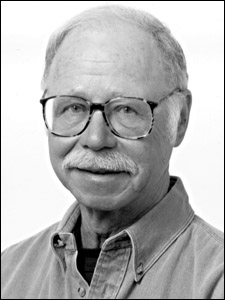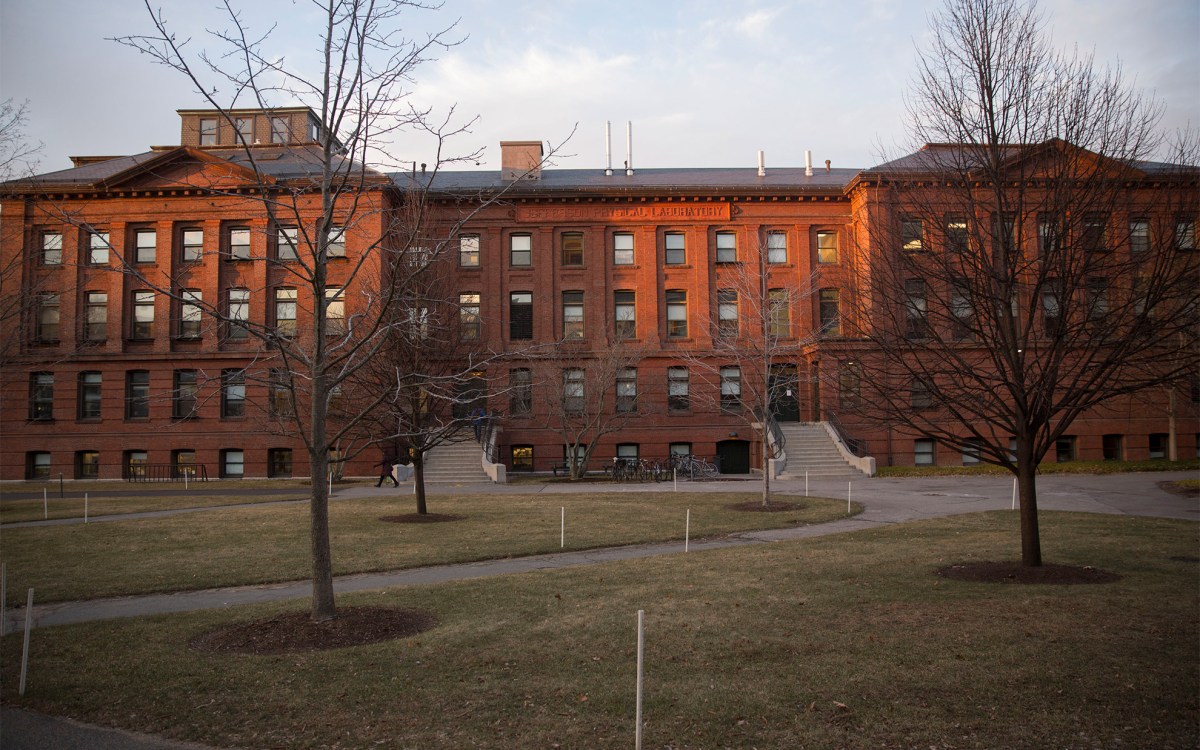Sanford Louis Palay
Faculty of Medicine – Memorial Minute
Sanford L. Palay died on August 5, 2002, at the age of 83, and was buried at Sleepy Hollow Cemetery in Concord, Massachusetts.

Sanford Palay was born in Cleveland in 1918 and received his bachelor’s degree from Oberlin College. Upon graduation in 1940, “Sandy,” as he was usually known, entered the School of Medicine at Case Western Reserve University with every intention of becoming a bacteriologist. But fortunately for neuroscience, he turned away from that path. The turning point came when he applied for a summer fellowship during the first year of medical school and was accepted into the laboratory of Ernst and Berta Scharrer, where the emphasis was on neurosecretion. It was upon this subject that Sandy carried out his first investigations. His association with the Scharrers continued throughout his medical school years, and his personal relationship with Ernst Scharrer had a great influence on Sandy’s scientific career.
After completing his M.D. degree in 1943, Sandy spent a year as an intern at New Haven Hospital, while in the evenings continuing his research into neurosecretion at the Department of Anatomy at Yale University. At the end of his internship, Sandy returned to Case Western Reserve, with appointments as a research fellow in Anatomy and a teaching follow in Medicine. His association with Ernst Scharrer continued, and Scharrer suggested that Sandy should consider going to the Rockefeller Institute to work with Albert Claude. Claude was one of the early workers on the biochemistry of cellular components, which was the beginning of cell biology. Although he had been awarded a postdoctoral fellowship to work with Claude, Sandy was called up to serve with the Army Medical Corps in occupied Japan. This was a mixed blessing; although this interrupted his scientific career, Sandy began a lifelong interest in Japanese art and culture. This led him to study and to collect Japanese art, as well as to grow bonsai specimens.
On his return from the forces, Sandy went to the Rockefeller Institute to work with Albert Claude and spent a year examining salivary gland chromosomes by electron microscopy, using formvar replicas. This was one of the few means available at that time for examining biological specimens by electron microscopy. At the end of the year, Sandy returned to Yale, where he was appointed first as an Instructor and then as an Assistant Professor of Anatomy.
By 1952, great strides had been made in the preparation of specimens for electron microscopy, including techniques for obtaining good preservation of tissues, for embedding in methacrylate, and cutting thin sections using glass knives on newly developed ultramicrotomes. So when George Palade invited Sandy to return to the Rockefeller Institute to work with him for six months and to learn these new techniques of electron microscopy, Sandy gladly accepted the invitation. This marked the beginning of Sandy Palay’s career as one of the foremost neurocytologists of the twentieth century. One of his first achievements was to describe the ultrastructural details of the synapse in the central nervous system. In effect, his demonstration in 1953 that there is a gap between the axon terminal and the postsynaptic component of the synapse validated the neuron doctrine and finally lay to rest any question that the nervous system is a syncytium.
In 1953, Sandy returned to Yale as an Associate Professor of Anatomy, but stayed there for only one more year, because his prominence as a neurocytologist led him to be appointed to the position of Chief of the Section of Neurocytology at the National Institutes of Health in Bethesda. Three years later, he was promoted to the position of Chief of the Laboratory of Neuroanatomical Science, and while he was at the NIH, he continued his work on the ultrastructure of synapses, as well as studying neurosecretion and neuroglia.
In 1961, Sandy Palay accepted Don Fawcett’s invitation to become the Bullard Professor of Neuroanatomy at Harvard Medical School. By then, Sandy had become a dominant figure in the field of the fine structure of the nervous system. Soon after his arrival at Harvard, Sandy and his colleagues improved the quality of preservation of central nervous tissue by the introduction of a method to fix central nervous tissue by perfusion with osmic acid. This produced a much superior preservation than the existing method of fixation by immersion of tissue in an osmic acid solution. It enabled Sandy and his colleagues to produce electron microscopic images of superior quality, backed up by lucid descriptions of many components of the nervous system, which were being seen in detail for the first time. In addition, Sandy showed how it was possible to correlate light microscopic images of neurons visualized in material impregnated by the classical Golgi method with the images of the same cells as there were seen in electron microscopic preparations, thus bridging the gap between light and electron microscopy of the central nervous system. Putting this particular technique to good use, Sandy and his wife, Victoria Chan-Palay, carried out detailed analyses of the cerebellum, and this work culminated in the publication of their book Cerebellar Cortex: Cytology and Organization. This book was published in 1974 and is considered one of the seminal contributions to the field of neurocytology, since it did much to unravel the complexities of the neuronal circuits in the cerebellum.
As his ultrastructural studies progressed, Sandy developed criteria for identifying many of the profiles of the cell bodies and processes of the myriad types of cells present in the central nervous system, and in 1970, he co-authored the book The Fine Structure of the Nervous System with Alan Peters and Harry Webster. The intent of this book was to serve as a guide to help in the analysis of electron micrographs of the nervous system and because of the popularity of the book, three editions have been published, the last one in 1991.
Sandy liked to teach and to pass on information to others, and he also had high standards for illustrations and for writing. This may be the reason why, in 1980, he agreed to become the Editor-in-Chief of the Journal of Comparative Neurology. Sandy took a personal interest in every manuscript submitted to the Journal and wrote careful and detailed letters to authors about how they might improve their submissions. He was also careful in his selection of members of his Editorial Board. Consequently, during his tenure of fourteen years as Editor-in-Chief, the Journal continued to grow in stature, in quality, and in the number of articles submitted for publication. As mentioned, Sandy edited the Journal for fourteen years, so that even after his retirement from Harvard in 1989, he continued as Editor-in-Chief, doing his work in the basement of his home in Concord.
After his retirement from Harvard, Sandy accepted a position as Distinguished Scholar-in-Residence in the Department of Biology at Boston College. He enjoyed this position because it brought him back into contact with students, to whom he offered a course in the history of neuroscience, a subject for which he had a deep understanding and love. Even when his health began to decline, Sandy continued to teach this course until the spring of 2002, the students going to his home for their seminars. He also served on several graduate student thesis committees during this period, and shared his expertise in neurocytology with the Biology Faculty at Boston College.
Without doubt, Sanford Palay was one of the outstanding neuroscientists of the last century, and his achievements were recognized by his many awards. Among these may be cited his election to the American Academy of Arts and Science and to the National Academy of Sciences. He was also elected President of the American Association of Anatomists, which awarded him the Henry Gray Award for his contributions to anatomy and for his outstanding achievements in science. He was presented with the Ralph Gerard Award for contributions to neuroscience by the Society for Neuroscience, and had many distinguished lectureships to his credit. In addition his analytical qualities made Sanford Palay much sought after by journals who wanted him as a member of their editorial boards, and so in addition to the Journal of Comparative Neurology, he served on the editorial boards of such journals as the Journal of Neurocytology; Experimental Neurology; the Journal of Cell Biology; Neuroscience; Brain Research; Experimental Brain Research; and Ultrastructural Research.
Most importantly, Sandy is remembered by those who knew him as an innovator, thinker, and influential mentor. He truly helped to shape the field of neuroscience as we now perceive it, and his influence will be felt, through his colleagues and students, for many years to come.
Respectfully submitted,
Alan Peters, Chairperson
Grant W. Balkema
Elio Raviola
Clifford B. Saper




